Italy beckons travelers with its intoxicating blend of ancient history, Renaissance art, and culinary mastery, making it essential to identify the best places to visit in Italy before embarking on your Mediterranean adventure. From the romantic canals of Venice to the sun-drenched Amalfi Coast, this boot-shaped peninsula offers experiences that have captivated visitors for centuries. Whether you’re drawn to Rome’s imperial grandeur, Florence’s artistic treasures, or the rolling vineyards of Tuscany, Italy presents a tapestry of destinations that cater to every type of traveler.
Rome
The Colosseum

The Colosseum (or Coliseum) is perhaps Rome’s most iconic landmark – an enormous amphitheater built between 70-80 CE during the Flavian dynasty. This massive stone structure could hold between 50,000-80,000 spectators who came to watch gladiatorial contests, animal hunts, executions, battle reenactments, and even mock naval battles when the arena was flooded.
The Colosseum represents the engineering prowess of ancient Rome and provides essential insights into Roman entertainment and social structure.
Location: Piazza del Colosseo, 1, 00184 Roma RM, Italy
Connectivity: By Metro:
- Line: Metro Line B.
- Station: Colosseo.
Vatican City

While technically an independent city-state, Vatican City sits within Rome and serves as the spiritual and administrative headquarters of the Roman Catholic Church.
At just 49 hectares (121 acres), it’s the world’s smallest sovereign state but contains immense cultural treasures including St. Peter’s Basilica, the Sistine Chapel with Michelangelo’s famous ceiling, and the Vatican Museums housing one of the world’s most significant art collections spanning thousands of years.
Connectivity: From Rome to Vatican City
By train:
Roma Termini → Roma S. Pietro
By Metro:
Metro Line-A to Ottaviano-S
Roman Forum

The Roman Forum was the beating heart of ancient Rome – the center of political, religious, commercial, and judicial life. This rectangular plaza surrounded by the ruins of important government buildings served as the venue for public speeches, elections, criminal trials, commercial affairs, and religious ceremonies.
Walking through the Roman Forum today allows visitors to step back in time to when Rome was the center of Western civilization.
Connectivity: By Metro:
- Line: Metro Line B.
- Station: Colosseo.
By Bus:
Numbers 64 & 75
Station: Roma Termini -> “Fori Imperiali/Campidoglio”
Trevi Fountain

This magnificent Baroque fountain completed in 1762 is one of the largest and most spectacular fountains in the world. The central figure depicts Neptune, god of the sea, flanked by tritons.
The tradition of throwing a coin into the fountain (right hand over left shoulder) is said to ensure a return visit to Rome. The fountain collects approximately €1.5 million annually, which is donated to charity.
Connectivity: By Metro:
- Line: Metro Line A.
- Station: Barberini-Fontana di Trevi .
By Bus:
- Numbers 64
- Station: Roma Termini -> Nazionale/Palazzo Esposizioni
- Number: 71
- Station: panisperna -> tritone/fontana trevi
Pantheon

One of ancient Rome’s best-preserved buildings, the Pantheon was built around 126 CE during Emperor Hadrian’s reign. Its perfect proportions (the height of the dome equals the diameter of the interior circle) and remarkable engineering make it an architectural marvel.
The name comes from Greek words meaning “honor all gods,” reflecting its original purpose as a temple. The oculus, an opening at the top of the dome, is the building’s only source of natural light and creates a moving spotlight effect throughout the day.
Address: Piazza della Rotonda, 00186 Rome, Italy
Connectivity:
By Metro:
- Line: Metro Line A.
- Station: Barberini station.
By Tram:
- Line: Metro Line 8.
- Station: Piazza Venezia.
By Bus:
- Line: 64, 30, 70, 81, 87, 62, 83, 85, 160, 492, 40, 60 and 628.
- Station: Corso – Minghetti, Corso Rinascimento, Largo di Torre Argentina.
St. Peter’s Basilica

One of Christianity’s holiest sites and an extraordinary achievement of Renaissance architecture, St. Peter’s Basilica was built over what is traditionally considered to be the burial site of St. Peter, one of Jesus’s apostles and the first Pope.
The current basilica, completed in 1626, features works by many renowned artists including Michelangelo’s Pietà sculpture and his design for the magnificent dome. The interior is breathtaking in scale and decoration.
Address: Piazza San Pietro, 00120 Città del Vaticano, Vatican City
Connectivity:
By Metro:
- Line: Metro Line A.
- Station: Ottaviano-S
By Bus:
- Line: 64, 32,81, 982
- Station: Via di Porta Cavalleggeri, Piazza del Risorgimento(about 10 minutes away)
By Train:
Station: Roma San Pietro station
Palatine Hill

One of Rome’s seven hills, the Palatine occupies a central position overlooking the Roman Forum on one side and the Circus Maximus on the other. According to Roman mythology, this is where Romulus and Remus were found by the she-wolf, and where Romulus eventually founded the city in 753 BCE.
The hill became an exclusive residential area for Roman emperors and aristocracy, with extensive palaces and gardens whose ruins can still be explored today.
Address: 00186 Rome, Metropolitan City of Rome, Italy
Connectivity:
By Metro:
- Line: Metro Line B.
- Station: Colosseo station
By Bus:
- Line: 87, 85 and 51, 75, 81, 118.
- Station: Fori Imperiali/Campidoglio
By Tram:
- Line: Metro Line 3, 8.
- Station: Piazza del Colosseo station
Capuchin Crypt

Located beneath the church of Santa Maria della Concezione dei Cappuccini, this unusual site contains the skeletal remains of approximately 3,700 Capuchin friars arranged in elaborate decorative patterns. The bones form chandeliers, arches, and other ornamental displays across six small chapels.
Rather than being macabre, the crypt was designed as a profound reminder of human mortality and the swift passage of life on earth – a physical manifestation of the memento mori (“remember you must die”) tradition in Christianity.
Address: Via Vittorio Veneto, 27, 00187 Roma RM, Italy.
Connectivity:
By Metro:
- Line: Metro Line A.
- Station: Barberini
By Bus:
- Line: 52, 63, or 175
- Station: Barberini (ma)
Venice
St. Mark’s Square (Piazza San Marco)

The heart of Venice, St. Mark’s Square represents the social, religious, and political center of Venetian life for centuries. Napoleon once called it “the drawing room of Europe,” and when you stand in this magnificent public space, you’ll understand why. The square is bordered by arcaded buildings and dominated by three major structures:
St. Mark’s Basilica is the crown jewel of the square—a masterpiece of Byzantine architecture completed in the 11th century. The church’s exterior features dramatic domes and intricate mosaics, while the interior glitters with gold mosaics covering over 8,000 square meters of wall and ceiling space. These tell biblical stories and Venetian histories, creating an atmosphere that feels both reverent and opulent.
The Campanile (bell tower) stands at 98.6 meters tall and offers one of the best panoramic views of Venice and its lagoon. What many visitors don’t realize is that the current tower is actually a reconstruction—the original collapsed suddenly in 1902, remarkably injuring only the caretaker’s cat.
Doge’s Palace (Palazzo Ducale) served as both the residence of the Doge (Venice’s elected leader) and the seat of government for the Venetian Republic. Its distinctive Gothic façade features a pattern of pink Verona marble and white Istrian stone. Inside, you’ll find lavishly decorated council chambers and the famous Bridge of Sighs, which connects the palace to the historic prison.
Connectivity:
Vaporetto (Water Bus):
- Station: Rialto stop: 1, 2, N.
- San Marco- Vallaresso: 1, 2, N.
- San Marco-San Zaccaria: 1, 2, 4.1, 4.2, 5.1, 5.2, 14, 20, N.
By Bus:
- Line:
- Station: wb flamingo after linq
Water Taxi:
- Alilaguna water bus: Blue Line to San Marco stop
Grand Canal

Venice’s main thoroughfare isn’t a street but a sinuous S-shaped waterway cutting through the heart of the city. A journey along the Grand Canal is like traveling through a living museum of architectural styles spanning nearly 1,000 years:
The best way to experience the canal is via vaporetto (water bus), particularly line #1, which travels the entire length making frequent stops. This gives you time to admire the parade of palaces lining both sides—from Byzantine and Gothic to Renaissance and Baroque. Each building tells a story of Venice’s wealthy merchant families who competed to build increasingly grand homes.
Rialto Bridge, the oldest and most famous of the four bridges spanning the Grand Canal, was completed in 1591. Its distinctive single marble arch supports two rows of shops and offers spectacular views of the bustling waterway below.
The Islands of the Venetian Lagoon

While the main city demands your attention, the surrounding lagoon islands offer fascinating glimpses into different aspects of Venetian culture:
Murano has been famous for its glass production since 1291, when all glass furnaces were moved from Venice proper due to fire concerns. Visiting a glass factory demonstration shows you the incredible skill that goes into creating Murano’s signature colorful glassware—a tradition passed down through generations of master craftsmen.
Burano is immediately recognizable by its brightly colored houses painted in various hues of pink, blue, green, and yellow. Legend claims this tradition began so fishermen could identify their homes through the lagoon fog. The island is also renowned for its delicate lace-making tradition, though few authentic practitioners remain today.
Torcello holds special significance as one of the earliest settled islands in the Venetian lagoon. Today it’s largely rural, but its magnificent Cathedral of Santa Maria Assunta contains spectacular Byzantine mosaics dating from the 11th and 12th centuries, including a haunting depiction of the Last Judgment.
Connectivity:
Murano
- Vaporetto lines: 4.1, 4.2, 12, 13 from Fondamente Nove
- Journey time: ~15 minutes from Fondamente Nove
- Nearby stations: Murano Colonna, Murano Faro, Murano Museo, Murano Navagero, Murano Venier
Burano
- Vaporetto lines: 12 from Fondamente Nove
- Journey time: ~45 minutes from Fondamente Nove
- Nearby stations: Burano (main stop), Mazzorbo (connected to Burano by bridge)
Torcello
- Vaporetto line: 12 from Fondamente Nove, then transfer at Burano to line 9
- Journey time: ~45 minutes to Burano, then 5 minutes to Torcello
- Nearby station: Torcello (single stop)
Lido
- Vaporetto lines: 1, 5.1, 5.2, 6, 10 from San Marco
- Journey time: ~15 minutes from San Marco
- Nearby stations: Lido Santa Maria Elisabetta (main stop), San Nicolò, Lido Casino
San Giorgio Maggiore
- Vaporetto line: 2 from San Marco-San Zaccaria
- Journey time: ~3 minutes from San Marco
- Nearby station: San Giorgio (single stop)
Giudecca
- Vaporetto lines: 2, 4.1, 4.2 from San Marco-San Zaccaria
- Journey time: ~5 minutes from San Marco
- Nearby stations: Palanca, Redentore, Zitelle
Key Departure Points:
- Fondamente Nove: Main departure point for Murano, Burano, and Torcello
- San Marco-San Zaccaria: Main departure point for Lido, San Giorgio Maggiore, and Giudecca
- Piazzale Roma: Connection point for buses to/from mainland
An ACTV vaporetto day pass (€20) is recommended if you plan to visit multiple islands in one day.
Venetian Art Treasures
The Gallerie dell’Accademia houses the most comprehensive collection of Venetian painting anywhere, spanning from Byzantine influences through the Renaissance to the 18th century. Here you’ll find masterpieces by Bellini, Titian, Tintoretto, Veronese, and Giorgione that showcase Venice’s distinctive painting style, known for its rich color and atmospheric effects.
Scuola Grande di San Rocco contains Tintoretto’s greatest achievement—a cycle of more than 50 paintings completed over 23 years. What makes this place special is experiencing these powerful works in situ, exactly where the artist intended them to be seen, with natural light changing their appearance throughout the day.
Peggy Guggenheim Collection offers an entirely different artistic experience, housed in the American heiress’s former home on the Grand Canal. This outstanding collection of 20th-century art includes works by Picasso, Kandinsky, Pollock, and Dalí, demonstrating how Venice has continued to inspire and house important art into the modern era.
Connectivity:
Gallerie dell’Accademia
- Location: Dorsoduro district
- Vaporetto: Line 1 or 2 to Accademia stop
- Nearby stations: Accademia, Salute, Zattere
Peggy Guggenheim Collection
- Location: Dorsoduro district
- Vaporetto: Line 1 to Salute stop
- Nearby stations: Salute, Accademia
Scuola Grande di San Rocco (Tintoretto masterpieces)
- Location: San Polo district
- Vaporetto: Line 1 to San Tomà stop
- Nearby stations: San Tomà, San Silvestro
Ca’ Rezzonico (Museum of 18th Century Venice)
- Location: Dorsoduro district
- Vaporetto: Line 1 to Ca’ Rezzonico stop
- Nearby stations: Ca’ Rezzonico, San Tomà
Ca’ Pesaro (Modern Art Museum)
- Location: Santa Croce district
- Vaporetto: Line 1 to San Stae stop
- Nearby stations: San Stae, Riva di Biasio
Palazzo Fortuny
- Location: San Marco district
- Vaporetto: Line 1 or 2 to Rialto stop
- Nearby stations: Rialto, San Silvestro
St. Mark’s Basilica Treasures & Mosaics
- Location: St. Mark’s Square
- Vaporetto: Lines 1, 2, N to San Marco-Vallaresso or San Marco-San Zaccaria
- Nearby stations: San Marco-Vallaresso, San Marco-San Zaccaria
Palazzo Ducale (Doge’s Palace)
- Location: St. Mark’s Square
- Vaporetto: Lines 1, 2, N to San Marco-San Zaccaria
- Nearby stations: San Marco-San Zaccaria, San Marco-Vallaresso
Punta della Dogana (Contemporary Art)
- Location: Dorsoduro district, at the tip
- Vaporetto: Line 1 to Salute stop
- Nearby stations: Salute, San Marco-San Zaccaria
Galleria Giorgio Franchetti alla Ca’ d’Oro
- Location: Cannaregio district
- Vaporetto: Line 1 to Ca’ d’Oro stop
- Nearby stations: Ca’ d’Oro, Rialto
Consider purchasing the Venice Museum Pass for access to multiple museums, or the Museum Pass + ACTV transport card combo for convenient travel between art destinations.
Milan
The Duomo (Milan Cathedral)

Gothic masterpiece with 135 marble spires and 3,400 statues. Take the elevator to the rooftop for spectacular views of Milan and the distant Alps. The interior features massive pillars and beautiful stained glass windows.
Address: Piazza del Duomo, 20122 Milano MI, Italy
Connectivity:
By Metro:
- Duomo: Direct access (Lines M1, M3)
- San Babila: 5-minute walk (Line M1)
- Cordusio: 5-minute walk (Line M1)
- Missori: 5-minute walk (Line M3)
- Montenapoleone: 10-minute walk (Line M3)
By Bus:
- Line: 57, 60, 73, and B15
- Station: L.go Augusto
By Tram:
- Lines 2, 14: Stop at “Duomo” or “Torino”
- Line 24: Stop at “Duomo”
- Line 27: Stop at “Duomo”
The Last Supper (Il Cenacolo)

Leonardo da Vinci’s masterpiece at Santa Maria delle Grazie church. This iconic mural captures the moment Jesus announces his betrayal. Visits require reservations months in advance due to strict visitor limitations.
Connectivity:
By Metro:
- Line: 1, 3.
- Station: Conziliazone, Cadorno
By Bus:
- Line: 50, 169.
- Station: Boccaccio
By Tram:
- Line: 16
- Station: S. Maria delle Grazie
Galleria Vittorio Emanuele II

Italy’s oldest active shopping mall, characterized by its stunning glass dome roof and mosaic floors. Home to luxury boutiques, historic cafés, and the tradition of spinning on the bull mosaic for good luck.
Connectivity:
By Metro:
- Duomo: Direct access (Lines M1, M3)
- Cordusio: 3-minute walk (Line M1)
- San Babila: 7-minute walk (Line M1)
- Missori: 7-minute walk (Line M3)
- Montenapoleone: 10-minute walk (Line M3)
By Bus:
- Line: M2, M3
- Station: Via Larga.
By Tram:
- Lines 1, 2, 14: Stop at “Duomo” or “Via Torino”
- Line 24: Stop at “Duomo”
- Line 27: Stop at “Duomo”
Teatro alla Scala (La Scala Opera House)

World-renowned opera house opened in 1778. Visit the La Scala Museum to see theatrical memorabilia and possibly peek into the opulent red and gold theater when rehearsals aren’t underway.
Connectivity:
By Metro:
- Duomo: 5-minute walk (Lines M1, M3)
- Montenapoleone: 5-minute walk (Line M3)
- Cordusio: 7-minute walk (Line M1)
- Lanza: 10-minute walk (Line M2)
- Cairoli: 12-minute walk (Line M1)
By Bus:
- Line: 61, 57, 94
- Station: Piazza della Scala, Via Manzoni.
By Tram:
- Line 1: Stop at “Via Manzoni – Scala” (closest to the theater)
- Lines 2, 14: Stop at “Via Manzoni” or “Duomo”
- Line 4: Stop at “Via Verdi” (very close to the theater entrance)
Castello Sforzesco

Imposing Renaissance fortress housing several museums including art collections and Michelangelo’s final unfinished sculpture, the Rondanini Pietà. The castle grounds lead to Parco Sempione.
Connectivity:
By Metro:
- Cairoli: 250 meters (3-minute walk) – Line M1
- Cadorna FN: 650 meters (8-minute walk) – Lines M1, M2
- Lanza: 750 meters (9-minute walk) – Line M2
- Cordusio: 800 meters (10-minute walk) – Line M1
- Moscova: 900 meters (11-minute walk) – Line M2
By Bus:
- Line 50: Stop at “Cairoli M1”
- Line 57: Stop at “Cairoli M1”
- Line 94: Stop at “Cadorna”
- Line 58: Stop at “Lanza M2”
By Tram:
- Lines 1, 4, 19: Stop at “Cairoli M1”
- Lines 2, 4, 12, 14: Stop at “Lanza M2”
- Lines 1, 10: Stop at “Cadorna”
Pinacoteca di Brera
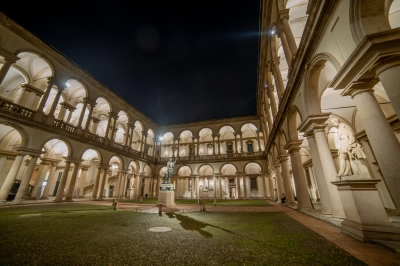
Premier art gallery featuring masterpieces from Northern Italian Renaissance and Baroque periods. Highlights include Mantegna’s “Dead Christ,” Raphael’s “Marriage of the Virgin,” and Hayez’s “The Kiss.”
Connectivity:
By Metro:
- Lanza: 500 meters (6-minute walk) – Line M2
- Montenapoleone: 700 meters (9-minute walk) – Line M3
- Cairoli: 800 meters (10-minute walk) – Line M1
- Moscova: 900 meters (11-minute walk) – Line M2
- Turati: 950 meters (12-minute walk) – Line M3
By Bus:
- Line 57: Stop at “Foro Buonaparte – Cusani”
- Line 61: Stop at “Via Pontaccio”
- Line 94: Stop at “Via Cusani”
By Tram:
- Lines 1, 12, 14: Stop at “Via Cusani – Lanza M2”
- Line 2: Stop at “Via Brera”
- Line 4: Stop at “Via Ponte Vetero”
Navigli District

Milan’s canal district offers a contrasting atmosphere to the city center. Home to vibrant nightlife, antique markets, art galleries, and countless restaurants serving aperitivo along the waterfront.
Connectivity:
By Metro:
- Porta Genova FS: Direct access to the heart of Navigli – Line M2
- Sant’Agostino: 800 meters (10-minute walk) to northern Navigli – Line M2
- Romolo: 1 kilometer (12-minute walk) to southern Navigli – Line M2
- Missori: 1.5 kilometers (18-minute walk) to eastern Navigli – Line M3
- Duomo: 2 kilometers (25-minute walk) – Lines M1, M3
By Bus:
- Line 74: Stops along “Via Vigevano” and “Via Gorizia”
- Line 47: Stop at “Porta Genova FS”
- Line 59: Stops along “Via Gorizia”
- Line 90/91 (circular route): Stop at “Porta Genova”
By Tram:
- Line 2: Stop at “Porta Genova FS” or “Corso San Gottardo”
- Line 9: Stop at “Porta Genova FS”
- Line 10: Stops along “Viale Gorizia” and “Alzaia Naviglio Grande”
- Lines 3, 15: Stop at “Porta Ticinese”
Quadrilatero della Moda (Fashion District)
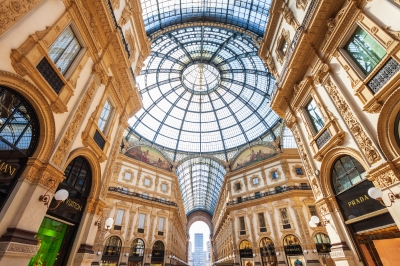
The world’s most prestigious shopping area encompassing Via Montenapoleone and surrounding streets. Home to flagship stores of famous Italian and international designers.
Connectivity:
By Metro:
- Montenapoleone: Direct access to the western side of the district – Line M3
- San Babila: 200 meters (3-minute walk) to the southern side – Line M1
- Palestro: 400 meters (5-minute walk) to the eastern side – Line M1
- Turati: 600 meters (7-minute walk) to the northern side – Line M3
- Duomo: 700 meters (9-minute walk) – Lines M1, M3
By Bus:
- Line 61: Stop at “Via Senato”
- Line 94: Stop at “Via Manzoni”
- Line 54: Stop at “Corso Vittorio Emanuele II”
- Line 73: Stop at “San Babila”
By Tram:
- Line 1: Stop at “Via Manzoni – Montenapoleone M3”
- Line 1: Stop at “Piazza Cavour”
- Line 9: Stop at “Via Manzoni”
- Line 4: Stop at “Via Senato”
Chiesa di San Maurizio al Monastero Maggiore

Often called “Milan’s Sistine Chapel” for its breathtaking interior completely covered in Renaissance frescoes by Bernardino Luini and other Leonardo da Vinci’s followers.
Connectivity:
By Metro:
- Cairoli: 550 meters (7-minute walk) – Line M1
- Cadorna FN: 750 meters (10-minute walk) – Lines M1, M2
- Sant’Ambrogio: 800 meters (10-minute walk) – Line M2
- Cordusio: 1 kilometer (12-minute walk) – Line M1
- Lanza: 1.1 kilometers (14-minute walk) – Line M2
By Bus:
- Line 50: Stop at “Via Meravigli” (near Cairoli)
- Line 58: Stop at “Corso Magenta – Via Nirone”
- Line 94: Stop at “Cadorna FN M1 M2”
By Tram:
- Line 16: Stop at “Corso Magenta – Via Nirone” (closest stop)
- Line 19: Stop at “Via Carducci – Corso Magenta”
- Lines 1, 2, 4: Stop at “Via Meravigli” (near Cairoli)
Leonardo da Vinci National Museum of Science and Technology

Housed in a 16th-century monastery, this museum displays models created from Leonardo’s drawings, along with extensive collections related to transport, energy, and space exploration.
Connectivity:
By Metro:
- Sant’Ambrogio: 300 meters (5-minute walk) – Line M2
- Conciliazione: 600 meters (10-minute walk) – Line M1
By Bus:
- Line 50: Stop at “San Vittore” or nearby stops.
- Line 58: Stops right at the entrance of the museum.
- Line 94: Also stops near the museum
By Tram:
- Via Olona: Served by tram line 14.
- Viale San Michele del Carso: Served by tram line 10.
Florence
Uffizi Gallery

One of the world’s greatest art museums housing masterpieces of the Renaissance. The collection includes works by Botticelli (Birth of Venus, Primavera), Leonardo da Vinci, Michelangelo, Raphael, and Titian. The building itself, designed by Vasari, was originally offices (uffizi) for the Medici administration. Reserve tickets in advance to avoid the notoriously long lines.
Connectivity:
By Bus:
- Lines 23, 23A, 23B: These buses stop at Galleria Degli Uffizi, just a 3-minute walk from the gallery.
- Lines 6A, 6B: These buses stop nearby, requiring a short walk.
- Lines C1, C2, C3, C4: These central routes are useful for visitors coming from various parts of the city center
By Tram:
- Stations: San Marco – Università, Valfonda – Stazione S.M.N.
- Lines: 3
Duomo Complex (Cathedral of Santa Maria del Fiore)

Florence’s iconic cathedral features Brunelleschi’s revolutionary dome – the largest brick dome ever constructed. Climb the 463 steps to the top for panoramic city views.
The complex includes Giotto’s Campanile (bell tower), the ancient Baptistery with its magnificent bronze doors by Ghiberti, and the Duomo Museum housing Michelangelo’s Pietà and Donatello’s Mary Magdalene.
Connectivity:
By Bus:
- Lines C1, C2, C3: These buses stop at Proconsolo, Santa Maria Maggiore, and other nearby stops.
- Lines 6A, 6B, 11, 14, 23, 23N: These buses also stop near the Duomo, with stops like Vecchietti and Pucci Duomo
Nearest Bus Stops
- Proconsolo: A 4-minute walk from the Duomo.
- Santa Maria Maggiore: A 4-minute walk away.
- Vecchietti: A 4-minute walk from the Duomo.
- Pucci Duomo: A 5-minute walk away
By Tram:
- Stations: Santa Maria Novella:
- Lines: T1, T2.
Galleria dell’Accademia

Home to Michelangelo’s David, the 17-foot marble masterpiece that embodies Renaissance ideals of human form and beauty. The museum also houses Michelangelo’s unfinished Prisoners sculptures, seemingly struggling to break free from their marble blocks, along with important paintings by Botticelli and other Florentine masters.
Connectivity:
By Bus:
- Lines 14 and 23: These buses stop at Museo Di San Marco, which is a short walk from the gallery.
- Lines 6 and 31: Also stop nearby, providing easy access to the gallery.
Nearest Bus Stops
- Museo Di San Marco: A short walk from the gallery.
- Piazza San Marco: A 1-minute walk away.
By Tram:
- Stations: Santa Maria Novella
- Lines: T1, T2.
Ponte Vecchio

Florence’s oldest and most famous bridge spans the Arno River at its narrowest point. Built in 1345, it’s known for the shops built along its edges – originally occupied by butchers but now filled with jewelers and souvenir sellers.
The Vasari Corridor runs above the shops, a private elevated passageway built for the Medici to travel between the Pitti Palace and Uffizi.
Connectivity:
By Bus:
- Lines C1, C2, C3: These buses stop at nearby locations like Proconsolo and Santa Maria Maggiore.
- Lines 6 and 31: Also stop nearby, providing easy access to the bridge.
Nearest Bus Stops
- Proconsolo: A 4-minute walk from Ponte Vecchio.
- Santa Maria Maggiore: A 4-minute walk away.
- Vecchietti: A 4-minute walk from the bridge.
By Tram:
- Stations: Santa Maria Novella
- Lines: T1, T2.
Palazzo Pitti and Boboli Gardens

This massive Renaissance palace houses several museums including the Palatine Gallery (with works by Raphael, Titian, and Rubens) and the Royal Apartments. Behind the palace, the Boboli Gardens exemplify formal Italian garden design with fountains, grottos, and classical statues spread across 111 acres of terraced landscape.
Connectivity:
By Bus:
- Lines C3, C4, D, 11, 12, and 13: These buses stop at Borgo S. Jacopo, which is a short walk from the palace and gardens
Nearest Bus Stops:
- Borgo S. Jacopo: A short walk from Palazzo Pitti and Boboli Gardens.
- Piazza de’ Pitti: Close to the palace entrance.
By Tram:
- Stations: Unità.
Piazza della Signoria and Palazzo Vecchio

Florence’s main square serves as an open-air sculpture gallery featuring Cellini’s Perseus, Giambologna’s Rape of the Sabine Women, and a copy of Michelangelo’s David. The medieval Palazzo Vecchio (Old Palace) was the seat of Florentine government and is still used as the city hall. Inside, visitors can explore elaborately decorated chambers including the Hall of the Five Hundred.
Connectivity:
By Bus:
- Lines C1, C2, C3: These buses stop at nearby locations like Proconsolo and Santa Maria Maggiore.
- Lines 6 and 31: Also stop nearby, providing easy access to the square.
Nearest Bus Stops:
- Proconsolo: A 4-minute walk from Piazza della Signoria.
- Santa Maria Maggiore: A 4-minute walk away.
- Vecchietti: A 4-minute walk from the square.
By Tram:
- Stations: Santa Maria Novella.
- Lines: T1, T2.
San Lorenzo and Medici Chapels
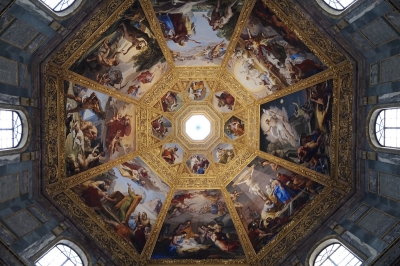
The Medici family church contains Michelangelo’s architectural masterpiece – the Laurentian Library with its unusual staircase. The attached Medici Chapels include the New Sacristy with Michelangelo’s sculptural groups representing Day, Night, Dawn, and Dusk on the Medici tombs, and the Chapel of the Princes, an opulent mausoleum decorated with precious stones.
Connectivity:
By Bus:
- Lines C1, C2, C3: These buses stop at nearby locations like Proconsolo and Santa Maria Maggiore.
- Lines 6 and 31: Also stop nearby, providing easy access to the basilica.
Nearest Bus Stops
- Proconsolo: A 4-minute walk from San Lorenzo.
- Santa Maria Maggiore: A 4-minute walk away.
- Vecchietti: A 4-minute walk from the basilica.
By Tram:
- Stations: Santa Maria Novella.
- Lines: T1, T2.
Piazzale Michelangelo

This panoramic terrace offers the most famous view of Florence, with the Duomo, Palazzo Vecchio, and Arno River spread before you. Built in the 19th century as part of urban renewal, it features bronze copies of Michelangelo’s sculptures. Particularly magical at sunset, when the city’s Renaissance skyline is bathed in golden light.
Connectivity:
By Bus:
- Bus 12 or 13: These buses depart from the city center and take about 10 minutes to reach the square
Nearest Bus Stops
- Piazzale Michelangelo: Directly at the square.
- Piazza Poggi: A short walk from the base of the hill leading to the square.
By Tram:
- Stations: Santa Maria Novella.
- Lines: T1, T2.
Mercato Centrale and San Lorenzo Market

Experience Florence’s culinary traditions at the two-story Mercato Centrale. The ground floor houses traditional vendors selling fresh produce, meats, and local specialties, while the upper floor offers prepared foods. Outside, the San Lorenzo Market stalls sell leather goods, clothing, and souvenirs in the tradition of Florence’s mercantile history.
Connectivity:
By Bus:
- Lines C1, C2, C3: These buses stop nearby, providing easy access to the markets.
Nearest Bus Stops
- Piazza del Mercato Centrale: Directly at the market.
- Via dell’Ariento: A short walk from the market.
By Tram:
- Stations: Santa Maria Novella.
- Lines: T1, T2.
Amalfi Coast
Positano

This postcard-perfect town is the jewel of the Amalfi Coast with its pastel-colored houses dramatically cascading down the cliffside to the azure Mediterranean Sea. The town centers around the Chiesa di Santa Maria Assunta with its majolica-tiled dome and 13th-century Byzantine Madonna icon.
Wander through narrow alleys lined with boutiques selling handmade sandals, linen clothing, and ceramics. Spiaggia Grande beach offers sunbathing opportunities, while restaurants like La Sponda and Le Sirenuse provide incredible dining experiences with coastal views.
For the adventurous, take the path to the quieter Fornillo Beach or hike to Nocelle village above the town.
Ravello

Perched 365 meters above the sea, Ravello offers a peaceful retreat from the coastal crowds. Villa Rufolo, dating back to the 13th century, features magnificent gardens that inspired Wagner’s opera Parsifal and hosts summer concerts during the Ravello Festival.
Nearby Villa Cimbrone boasts the “Terrace of Infinity” with its marble busts and arguably the most breathtaking panoramic view on the entire coast. The town’s elegant main square, Piazza Vescovado, is home to the impressive 11th-century Duomo (Cathedral) and charming cafés.
Oscar Niemeyer’s striking modern auditorium adds an architectural contrast to the medieval surroundings.
Amalfi Town

The coast’s namesake and historical maritime republic, Amalfi impresses with its magnificent Duomo di Sant’Andrea featuring striking black and white striped Byzantine-Arab-Norman architecture and a grand staircase leading to its entrance.
Inside, don’t miss the Cloister of Paradise (Chiostro del Paradiso) with its interlaced Moorish arches. The town’s Paper Museum (Museo della Carta) showcases Amalfi’s traditional handmade paper industry that dates back to the 13th century.
The lively main square, Piazza del Duomo, and the bustling marina offer numerous dining options and boat excursions. The ancient Arsenal of the Maritime Republic (Arsenale della Repubblica) gives insight into Amalfi’s powerful naval past.
Path of the Gods (Sentiero degli Dei)

This legendary 7.8 km hiking trail follows ancient mule paths between Agerola (specifically the hamlet of Bomerano) and Nocelle (above Positano). Walking among terraced vineyards and lemon groves, you’ll experience some of the Mediterranean’s most spectacular scenery with views stretching from the island of Capri to the Sorrento Peninsula.
The moderately challenging trail takes about 3-4 hours one-way and reveals hidden hamlets, wild flora, and dramatic limestone formations. Local legends claim the path was used by the gods to reach the sea and save Ulysses from the sirens.
Most hikers start in Bomerano and descend to Nocelle, following the path downhill.
Capri

Though technically not on the Amalfi Coast, this island paradise is easily accessible by boat from various coastal towns. The famous Blue Grotto (Grotta Azzurra) sea cave illuminates with an otherworldly blue light due to sunlight passing through an underwater cavity.
Take the chairlift to Monte Solaro, the island’s highest point, for panoramic views. The Gardens of Augustus offer spectacular vistas of the iconic Faraglioni rock formations. The elegant Piazzetta (officially Piazza Umberto I) serves as a sophisticated outdoor living room for people-watching.
Visit Villa Jovis, Emperor Tiberius’s spectacular cliff-top residence, or take the scenic boat trip around the island to see hidden coves and dramatic rock formations.
Furore

Known as “the town that doesn’t exist,” Furore isn’t a traditional town center but rather houses scattered along the hillside. Its magnificent fjord (Fiordo di Furore) is a narrow inlet with vertical limestone cliffs, crossed by a high arched bridge that hosts diving competitions.
The small pebble beach at the bottom of the fjord, though often shaded in the afternoon, is a unique swimming spot. The entire village is an “alfresco museum” with colorful murals painted on houses. Visit the tiny Anna Magnani Museum, dedicated to the acclaimed actress who filmed “L’Amore” here with Roberto Rossellini.
Furore is also known for its microclimate that produces excellent wines, particularly from the native Fenile and Ripoli grapes.
Atrani

Just a short walk east of Amalfi yet worlds apart in atmosphere, Atrani is the smallest municipality in Italy (by area) and retains an authentic fishing village charm. Its picturesque central square, Piazza Umberto I, is surrounded by charming restaurants and leads directly to a small but lovely beach.
The 10th-century Church of San Salvatore de’ Birecto was once the coronation site for the doges of the Maritime Republic of Amalfi. Climb the steps from the main square to the Church of Santa Maria Maddalena with its distinctive majolica dome overlooking the town.
Atrani’s medieval urban layout, with narrow alleys and covered passages, has remained largely unchanged over the centuries, making it a photographer’s paradise.
Valle delle Ferriere

This spectacular natural reserve near Amalfi provides a refreshing contrast to the coastal landscapes. The valley features lush vegetation, waterfalls, streams, and ruins of medieval ironworks (hence the name “Valley of the Ironworks”).
The microclimate supports rare plants including the Woodwardia radicans, a prehistoric fern dating back 65 million years. The upper part of the reserve (Riserva Integrale) protects the most pristine ecosystems.
The trail can be accessed from either Amalfi or Pontone (part of Scala), with the latter route offering more spectacular views. Several waterfalls along the path provide cooling spots during summer hikes, while the ruins of paper mills highlight the area’s industrial heritage.
Tuscany
Siena

This well-preserved medieval city centers around the distinctive shell-shaped Piazza del Campo, site of the famous Palio horse race. The striking black-and-white marble cathedral (Duomo) contains masterpieces by Donatello, Michelangelo, and Bernini.
Siena’s medieval tower houses, winding streets, and rich artistic heritage make it a fascinating contrast to Florence.
San Gimignano

Often called the “Medieval Manhattan,” this small hilltop town is famous for its remarkably well-preserved medieval towers. Of the original 72 towers, 14 remain, creating a distinctive skyline visible from miles away.
The town offers excellent examples of Romanesque and Gothic architecture, along with notable frescoes in its Collegiate Church.
Pisa

While most famous for its Leaning Tower, Pisa’s Campo dei Miracoli (Field of Miracles) is a UNESCO World Heritage site featuring four masterpieces of medieval architecture: the cathedral, baptistery, campanile (the leaning tower), and the Camposanto cemetery.
The city itself has much more to offer beyond this iconic complex, including a historic university and lovely riverfront areas.
Val d’Orcia

This stunning agricultural region epitomizes the quintessential Tuscan landscape that has inspired artists for centuries. Rolling hills dotted with cypress trees, golden fields, and isolated farmhouses create a timeless panorama.
Visit charming towns like Pienza (the “ideal Renaissance city”), Montalcino (home of Brunello wine), and Montepulciano (known for its Vino Nobile).
Chianti Region
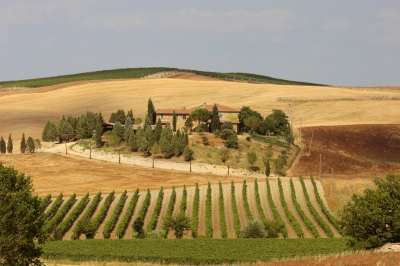
The famous wine region between Florence and Siena offers a perfect blend of natural beauty, historic towns, and culinary excellence.
Visit ancient castles now serving as wineries, such as Castello di Brolio, and explore charming towns like Greve, Radda, and Castellina in Chianti. Wine tastings and farm-to-table dining experiences are essential activities here.
Lucca

Unique for its fully intact Renaissance walls that now serve as a pedestrian promenade circling the city, Lucca offers a less touristy experience.
The elliptical Piazza dell’Anfiteatro, built on the remains of a Roman amphitheater, retains its original shape. Climb the unusual Guinigi Tower with oak trees growing from its top for a distinctive view.
Cortona
Made famous by Frances Mayes’ book “Under the Tuscan Sun,” this hillside town offers spectacular views over Lake Trasimeno and the surrounding countryside. Its Etruscan origins are evident in the city walls and archaeological museum.
The town’s steep, narrow streets reveal Renaissance palaces, medieval churches, and inviting piazzas.
Thermal Baths
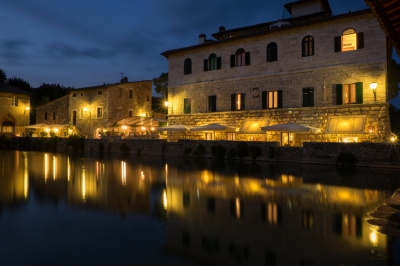
Tuscany has been known for its thermal waters since Etruscan and Roman times. Towns like Montecatini Terme, Bagno Vignoni (with its unique main square consisting of a pool of thermal water), and Saturnia (with its natural cascading hot springs) offer relaxing experiences in healing mineral waters.
Elba Island
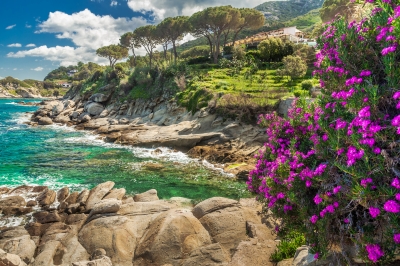
The largest island in the Tuscan Archipelago offers crystal-clear waters, beautiful beaches, and hiking trails. Historically significant as Napoleon’s place of exile, Elba combines natural beauty with fascinating history.
Naples and Pompeii
Naples (Napoli)
The Historic Center (Centro Storico)

Naples’ historic center is a UNESCO World Heritage site and represents one of Europe’s largest and most intact historical districts. Walking through these narrow streets is like traveling through different layers of history, from Greek foundations to medieval structures to baroque splendor.
The “Spaccanapoli” (literally “Naples splitter”) is a straight, narrow street that bisects the old historic center and dates back to the Greek-Roman city planning. As you walk this ancient thoroughfare, you’re following in footsteps laid down more than 2,500 years ago.
Connectivity:
By Bus:
Nearest Bus Stops
- Piazza Garibaldi: A major hub for buses and trams.
- Via Toledo: Buses stop nearby, though not directly in the Historic Center.
By Tram:
- Stations: Piazza Garibaldi.
- Lines: Tram Line 1
By Metro:
- Lines: Line 1, Line 2.
Nearest Metro Stops
- Università: A short walk from the Historic Center.
- Dante: Also near the Historic Center.
- Toledo: Close to the Spanish Quarter.
National Archaeological Museum (Museo Archeologico Nazionale)
This museum houses one of the world’s finest collections of Greco-Roman artifacts, with most treasures coming directly from Pompeii and Herculaneum. The “Secret Cabinet” (Gabinetto Segreto) contains ancient erotic art that was considered so scandalous it was kept locked away from the general public for centuries.
The Alexander Mosaic, recovered from Pompeii’s House of the Faun, depicts Alexander the Great in battle and represents one of the most detailed and skilled mosaics from antiquity.
Connectivity:
By Bus:
- Lines:R4, 201, 203, C55, 147, 168, 178, 184, and 139.
Nearest Bus Stops
- Piazza Museo Nazionale: Directly in front of the museum.
- Cavour – Metropolitana: A short walk away.
By Metro:
- Lines: Line 1, Line 2.
Nearest Metro Stops
- Museo: A minute’s walk from the museum.
- Cavour: An 8-minute walk from the museum.
Underground Naples (Napoli Sotterranea)

Beneath the bustling streets lies another city—a network of Greek-Roman aqueducts, catacombs, and tunnels later used as air raid shelters during World War II. This underground labyrinth tells the story of Naples from below, revealing how the city has continuously built upon itself over millennia.
The limestone extracted to build the underground chambers was used to construct the buildings above, creating a symbiotic relationship between Naples above and below ground.
Connectivity
By Bus:
- Lines: R4, 201, 203, C55, 147, 168, 178, and 184.
Nearest Bus Stops
- Piazza Museo Nazionale: A short walk from the historic center.
- Via dei Tribunali: Buses stop nearby.
By Metro:
- Lines: Line 1, Line 2.
Nearest Metro Stops
- Dante: A short walk from Piazza San Gaetano.
- Cavour: Also within walking distance.
Cappella Sansevero
This small chapel contains Giuseppe Sanmartino’s “Veiled Christ,” a marble sculpture so delicately rendered that the thin veil covering Christ appears translucent. The chapel also houses anatomical models with mysterious origins that have puzzled scientists for centuries.
The entire chapel represents the intersection of baroque art, esoteric symbolism, and scientific curiosity that characterized the Enlightenment period.
Connectivity
By Bus:
- Bus 151: Via Nuova Marina stop.
- Bus 154: Marchese Campodisola stop.
- Bus R2: Corso Umberto stop.
- Filobus 202: Corso Umberto stop.
By Metro:
- Lines: Line 1, Line 2.
Nearest Metro Stops
- Università (Line 1): About a 5-minute walk from Cappella Sansevero.
- Dante (Line 1): Also about a 5-minute walk away.
- Cavour (Line 2): An 8-minute walk from the chapel.
Castel dell’Ovo

Naples’ oldest castle sits on a small island and offers panoramic views of the Bay of Naples. According to legend, the Roman poet Virgil magically placed an egg in the foundations, and should this egg ever break, both the castle and Naples would face catastrophe. This folklore exemplifies the blend of classical history and magical thinking that permeates Neapolitan culture.
Connectivity
By Bus:
Bus 151: Take bus 151 to Piazza Vittoria and walk about 10-15 minutes along Via Partenope to reach the castle
Castel Nuovo (Maschio Angioino)

This medieval castle features a remarkable Renaissance triumphal arch celebrating Alfonso V of Aragon’s entry into Naples in 1443. The castle has witnessed key moments in the history of Naples as it passed between French, Spanish, and Italian control, reflecting the city’s complex political history.
Connectivity
By Bus:
- Lines: 101, 151, 201, R2, and N1.
By Metro:
- Lines: Line 1.
Nearest Metro Stops
- Municipio-Porto.
Naples Cathedral (Duomo)

The cathedral houses the Chapel of San Gennaro, containing the blood of Naples’ patron saint. Twice yearly, crowds gather to witness what many believe is the miraculous liquefaction of the dried blood. This phenomenon bridges ancient religious tradition with contemporary faith practices that remain central to Neapolitan identity.
Connectivity
By Bus:
- Lines: 101, 151, 201, R2, and N1.
By Metro:
- Lines: Line 1, Line 2.
Nearest Metro Stops
- Duomo (Line 1): About a 300-meter walk from the cathedral.
- Piazza Cavour (Line 2): About a 400-meter walk away.
Via San Gregorio Armeno
Famous for its artisan workshops creating nativity scenes (presepi), this street showcases Naples’ exceptional craftsmanship tradition. Beyond traditional figures, artisans incorporate contemporary celebrities and politicians, demonstrating how living tradition evolves while maintaining historical techniques.
Connectivity
By Bus:
- Lines: 101, 151, 201, R2, and N1.
By Metro:
- Lines: Line 1,.
Nearest Metro Stops
- Duomo (Line 1): About a 300-meter walk from the cathedral.
Pompeii
The Forum
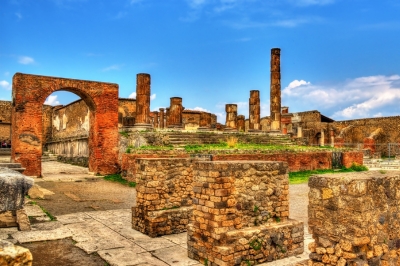
The political, religious, and commercial heart of ancient Pompeii provides insight into Roman civic life before the eruption of 79 CE. Standing in this open square with Vesuvius visible in the background creates a powerful connection between the ancient disaster and the present archaeological treasure.
Connectivity
By Train:
- Trains: Circumvesuviana Train, Campania Express.
- Stations: Pompei Scavi – Villa dei Misteri.
House of the Vettii
One of the best-preserved and most lavishly decorated private homes in Pompeii, it belonged to two wealthy merchants. The elaborate frescoes depict mythological scenes and daily life, offering a glimpse into both the aesthetic tastes and social aspirations of the wealthy Roman merchant class.
Connectivity
By Train:
- Trains: Circumvesuviana Train, Campania Express.
- Stations: Pompei Scavi – Villa dei Misteri.
Villa of the Mysteries
Located just outside the city walls, this villa contains a remarkable fresco cycle that may depict initiation into the cult of Dionysus. These mysterious images have challenged historians’ understanding of ancient religious practices and continue to generate new interpretations about private religious experiences in the Roman world.
The Amphitheater
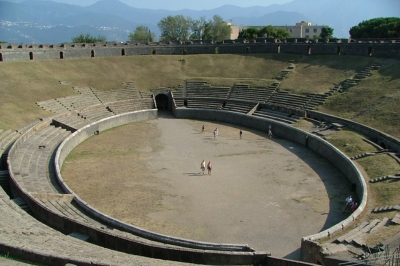
The oldest surviving Roman amphitheater, built around 70 BCE, could hold up to 20,000 spectators.
Interestingly, we know from historical records that a riot broke out here during a gladiatorial contest between locals and visitors from nearby Nuceria in 59 CE, resulting in a ten-year ban on games—just twenty years before the eruption permanently silenced the arena.
The Brothel (Lupanare)
This small building with explicit frescoes and stone beds offers insight into the regulated sex trade in Roman society. The erotic artwork served both as advertisement and as instruction for patrons who might not speak the local language, demonstrating the practical aspects of communication in a multiethnic Roman society.
Garden of the Fugitives

Plaster casts of victims caught in their final moments provide a haunting reminder of the human tragedy behind the archaeological site. These casts were created by pouring plaster into voids left in the hardened ash where bodies had decomposed, preserving the exact positions of people in their final moments. They represent one of the most direct emotional connections we can have with the ancient past.
House of the Tragic Poet
Despite its modest size, this house contains some of Pompeii’s finest mosaics, including the famous “Cave Canem” (Beware of the Dog) mosaic at the entrance. This juxtaposition of high artistic achievement in a middle-class home challenges our assumptions about access to art in Roman society.
The Bakeries and Thermopolia
These commercial establishments with intact ovens and food counters give us a vivid picture of how ordinary Romans purchased their daily food. The carbonized loaves of bread found in some bakeries are almost identical to traditional bread still baked in the region today, demonstrating culinary continuity across two millennia.
Lago di Como
Bellagio

The “Pearl of Lake Como” sits at the junction of the lake’s three branches. Wander through its perfectly preserved medieval center with narrow, steep streets lined with boutiques, cafés, and artisan shops. Don’t miss Villa Melzi Gardens with its azaleas, rhododendrons, and Egyptian sculptures. The lakefront promenade offers spectacular views across the water to the surrounding mountains.
Villa del Balbianello
Located on a wooded peninsula near Lenno, this 18th-century villa is famous for its elaborate terraced gardens and extraordinary views. Featured in movies like “Star Wars: Episode II” and “Casino Royale,” the villa houses a fascinating collection of artifacts from the expeditions of its last owner, explorer Guido Monzino. The meticulously maintained gardens with perfectly pruned trees are simply breathtaking.
Varenna
This authentic fishing village offers a more relaxed atmosphere than some of the lake’s more famous destinations. Its colorful houses cascade down to the waterfront, and the “Lovers’ Walk” (Passeggiata degli Innamorati) is a romantic lakeside promenade. Visit Villa Monastero with its botanical garden housing plants from around the world, and the nearby 11th-century Castello di Vezio with falconry displays and stunning panoramas.
Como City

The lake’s principal city combines Renaissance architecture with modern amenities. The magnificent Duomo (Cathedral) features Gothic and Renaissance elements with impressive tapestries and paintings. Take the funicular railway to Brunate for breathtaking views, explore the Tempio Voltiano museum dedicated to Alessandro Volta (inventor of the electric battery), and stroll through the elegant Piazza Cavour overlooking the harbor.
Villa Carlotta

This 17th-century villa in Tremezzo houses masterpieces by Canova and Hayez and is surrounded by 70,000 square meters of botanical gardens. Visit in spring when the 150+ varieties of azaleas and rhododendrons are in bloom. The villa’s terraced gardens offer spectacular views across to Bellagio, and the interior features ornate period furniture, frescoed ceilings, and marble sculptures.
Menaggio

This elegant resort town features a pretty waterfront promenade lined with oleanders and palm trees. The heart of town is the lively Piazza Garibaldi with outdoor cafés perfect for people-watching. Menaggio is also a gateway for hikers heading into the surrounding mountains, with trails offering spectacular lake views. Visit the remains of the medieval castle or play a round at the challenging 18-hole Menaggio & Cadenabbia Golf Club.
Lecco
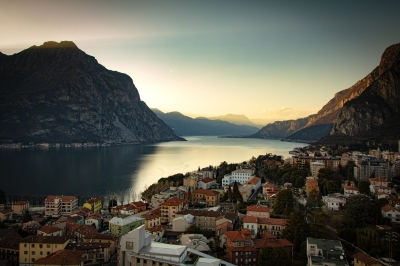
Situated at the end of the southeastern branch of Lake Como, Lecco is surrounded by mountains including the distinctive Resegone peak. The city has strong literary connections as the setting for Alessandro Manzoni’s famous novel “The Betrothed.” The beautiful waterfront features 19th-century buildings, and the Campanile di San Nicolò bell tower offers stunning panoramic views. The nearby Piani d’Erna cable car takes visitors to mountain hiking trails with spectacular vistas.
Nesso

This picturesque village between Como and Bellagio is built on a steep slope where a gorge divides the town in two. The highlight is the Orrido di Nesso, a spectacular gorge and waterfall that plunges directly into the lake, best viewed from the ancient Roman bridge. The small harbor (Nesso Porto) offers a glimpse of traditional lake life away from the tourist centers.
Isola Comacina

Lake Como’s only island has a rich history dating back to Roman times. Once home to numerous churches and fortifications, it was largely destroyed in 1169. Today, visitors can explore archaeological remains, enjoy a meal at the island’s famous restaurant Locanda dell’Isola Comacina (which has served the same menu since 1947), or attend the annual San Giovanni Festival with its spectacular fireworks display.
Cernobbio
This elegant town is home to some of Lake Como’s most impressive villas. Villa d’Este, now a luxury hotel, features magnificent Renaissance architecture and gardens with a floating swimming pool on the lake. Villa Erba, once home to director Luchino Visconti, hosts major events and exhibitions. The town’s center features charming squares and the beautiful lakeside promenade offers mountain views. Nearby, the challenging hiking trail Strada Regia connects Cernobbio to other lake villages.
The best time to visit Lake Como is from April to October, with May, June, and September offering pleasant weather with fewer crowds. Consider using the efficient ferry system to hop between these locations—seeing the towns from the water adds another dimension to your Lake Como experience.











